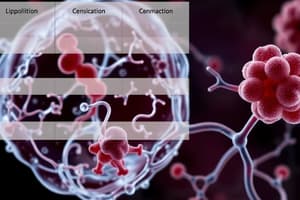Podcast
Questions and Answers
What does 'lipophobic' mean?
What does 'lipophobic' mean?
- Able to diffuse through the cell membrane of target cells
- Are not able to diffuse through the cell membrane of target cells (correct)
- Stimulates a genomic effect in target cells
- Bound to a transport protein in blood
Lipophobic substances are typically bound to a transport protein in blood.
Lipophobic substances are typically bound to a transport protein in blood.
False (B)
Where are lipophobic receptors found?
Where are lipophobic receptors found?
On cell membrane surfaces of target cells
Target cells generate a quick response when interacting with lipophobic substances.
Target cells generate a quick response when interacting with lipophobic substances.
Which of the following substances is lipophobic?
Which of the following substances is lipophobic?
What effect do lipophilic substances have on target cells?
What effect do lipophilic substances have on target cells?
Lipophilic substances have a relatively short half-life in circulation.
Lipophilic substances have a relatively short half-life in circulation.
How do lipophilic substances affect the response time of target cells?
How do lipophilic substances affect the response time of target cells?
Which of the following substances is lipophilic?
Which of the following substances is lipophilic?
Flashcards are hidden until you start studying
Study Notes
Lipophobic Characteristics
- Lipophobic substances cannot diffuse through the cell membranes of target cells.
- Typically, they are not bound to transport proteins in the bloodstream, making them less soluble in lipids.
- Their receptors are located on the surfaces of target cell membranes, facilitating rapid signal transduction.
- The response generated in target cells occurs quickly, ranging from seconds to several minutes.
- Key examples of lipophobic substances include hormones like dopamine, prolactin, somatotropin, and epinephrine.
Lipophilic Characteristics
- Lipophilic substances stimulate genomic effects within target cells, influencing gene expression.
- They have the ability to activate gene expression, leading to long-lasting changes in target cells.
- Lipophilic compounds generally exhibit a relatively long half-life in circulation compared to lipophobic substances.
- The response time in target cells is slow, often taking hours to manifest.
- Notable examples of lipophilic substances include hormones such as progesterone, T4 (thyroxine), T3 (triiodothyronine), and testosterone.
Studying That Suits You
Use AI to generate personalized quizzes and flashcards to suit your learning preferences.



